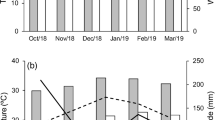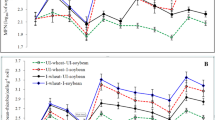Abstract
Effects of inoculating four Arachis hypogaea ssp. fastigiata cultivars with 17 Bradyrhizobium spp. strains were studied in a glasshouse experiment using a sandy soil devoid of an indigenous Bradyrhizobium population. Firstly, a wide range of parameters, indicative of symbiotic performance, were assessed for their influence on seed yield, by correlation and statistical analyses. It was found that nodule dry weight and leaf area were relevant parameters concerning seed yield. Secondly, the effects of host and strain genotype on those parameters were described.
Variations in nodule dry weight did not have an effect on seed yield, except for cultivar Natal Common at lower nodule dry weight values. Therefore, it was concluded that the quantity of nitrogen fixing tissue met the demand for combined nitrogen and did not limit seed yield. This conclusion was further supported by the observation that at low nodule numbers per plant the nodule size increased to generate sufficient nitrogen fixing tissue.
Leaf area, which comprises components for both photosynthetic capacity and plant development, was found to correlate well with seed yield. An increase in leaf area resulted in significant seed yield increases for all three spanish-type cultivars, but not for the valencia-type cultivar. Leaf area, thus, appeared as a factor limiting seed yield of spanish-type groundnuts.
Cultivar performance concerning seed yield was significantly better for Natal Common compared to the other three cultivars, while Natal Common had a significantly lower plant (biomass excluding seed) dry weight value.
Inoculation with different strains of Bradyrhizobium resulted in significantly different nodule dry weight values, but hardly led to significant differences in seed yield. This agreed with the finding that the amount of nitrogen fixing tissue appeared not to limit the availability of combined nitrogen.
A large quantity of nitrogen was partitioned to the groundnut seeds: 62% to 76% of total accumulated nitrogen was located in the seeds.
This study showed that testing for symbiotic effectiveness in the groundnut Bradyrhizobium symbiosis should include assessment of final (seed and biomass) yield, because parameters measured at stages prior to maturity, like nodulation parameters, may lead to flawed effectiveness ratings.
Similar content being viewed by others
References
Alwi N, Wynne J C, Rawlings J O, Schneeweis T J and Elkan G H 1989 Symbiotic relationship between Bradyrhizobium strains and peanut. Crop Sci. 29, 50–54.
Boddey R M, Urquiaga S, Neves M C P, Suhet A R and Peres J R 1990 Quantification of the contribution of N2 fixation to field-grown grain legumes-A stategy for the practical application of the 15N isotope dilution technique. Soil Biol. Biochem. 22, 649–655.
Bremner J M 1979 Total nitrogen. In Methods of Soil Analysis. Ed. C A Black. pp 1149–1178. Agronomy series No 9 part 2, Am. Soc. Agronomy, Madison, U.S.A.
Bray C M 1983 Nitrogen Metabolism in Plants. Longman Group Ltd. London New York. 214 p.
Chiteka A Z 1985 The present and future status of groundnut breeding and research in Zimbabwe. In Proceedings of the Regional Groundnut Workshop for Southern Africa 26–29 March 1984 Lilongwe Malawi. Eds. D McDonald and S R Beckerman. pp 125–134. ICRISAT, Patancheru, A.P., India.
De Mallorca M S and Izaguirre-Mayoral M L 1993 Ureide content and growth of cowpea (Vigna unguiculata (L.) Walp. var Tuy) plants as affected Bradyrhizobium strains and inoculum position. Soil Biol. Biochem. 25, 151–156.
Davis P E 1991 Report on legume-Rhizobium experiments conducted at the Soil Productivity Research Laboratory in the period December 1985 to November 1990. 78 p.
Gibbons R W 1980 The ICRISAT groundnut program. In Proceedings of the International Workshop on Groundnuts 13–17 October 1980 Patancheru India. Eds. R W Gibbons and J V Mervin. pp 12–16. ICRISAT, Patancheru, A.P., India.
Hardy R W F and Havelka U D 1976 Photosynthate as a major factor limiting nitrogen fixation by field-grown legumes with emphasis on soybeans. In Symbiotic Nitrogen Fixation in Plants. Ed. P S Nutman. pp 421–439. IBP 7, Cambridge University Press, Cambridge, UK.
Kishinevsky B D, Lobel R, Gurfel D and Nemas C 1992 Soil fumigation with methyl bromide as a means of increasing the occurrence of the inoculum strain in peanut nodules. Soil Biol. Biochem. 24, 845–848.
McCloud D E, Duncan W G, McGraw R L, Sibale P K, Ingram K T, Dreyer J and Campbell I S 1980 Physiological basis for increased yield potential in peanuts. In Proceedings of the International Workshop on Groundnuts 13–17 October 1980 Patancheru India. Eds. R W Gibbons and J V Mervin. pp 125–132. ICRISAT, Patancheru, A.P., India.
Mukurumbira L M 1985 Effect of rate of fertilizer nitrogen and previous grain legume crop on maize yields. Zimbabwe Agric. J. 82, 177–179.
Nambiar P T C and Dart P J 1980 Studies on nitrogen fixation by groundnut at ICRISAT. In Proceedings of the International Workshop on Groundnuts 13–17 October 1980 Patancheru India. Eds. R W Gibbons and J V Mervin. pp 110–124, ICRISAT, Patancheru, A.P., India.
Nambiar P T C 1985 Response of groundnut (Arachis hypogaea L.) to Rhizobium inoculation in the field: problems and prospects. MIRCEN J. 1, 293–309.
Nyamapfene K 1991 Soils of Zimbabwe. Nehanda Publishers, Harare, Zimbabwe.
Peoples M B, Pate J S, Atkins C A and Bergersen F J 1986 Nitrogen nutrition and xylem sap composition of peanut (Arachis hypogaea L. cv Virginia Bunch). Plant Physiol. 82, 946–951.
Vinod Pradhu K, Arunachalam V and Bandyopadhyay A 1990 Nonparametric approach to multitrait selection for yield in groundnut (Arachis hypogaea L.). Theor. Appl. Genet. 80, 223–227.
Williams J H, Dutta M and Nambiar P T C 1990 Light interception as a source of variation for nitrogen fixation in groundnut genotypes. Plant and Soil 121, 83–88.
Wynne J C, Elkan G H and Schneeweis T J 1980 Increasing nitrogen fixation of the groundnut by strain and host selection. In Proceedings of the International Workshop on Groundnuts 13–17 October 1980 Patancheru India. Eds. R W Gibbons and J V Mervin. pp 95–109. ICRISAT, Patancheru, A.P., India.
Author information
Authors and Affiliations
Rights and permissions
About this article
Cite this article
Van Rossum, D., Muyotcha, A., Van Verseveld, H.W. et al. Effects of Bradyrhizobium strain and host genotype, nodule dry weight and leaf area on groundnut (Arachis hypogaea L. ssp. fastigiata) yield. Plant Soil 154, 279–288 (1993). https://doi.org/10.1007/BF00012533
Received:
Accepted:
Issue Date:
DOI: https://doi.org/10.1007/BF00012533




